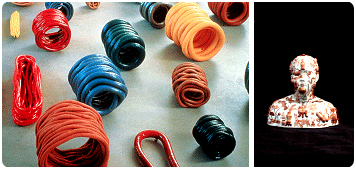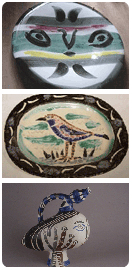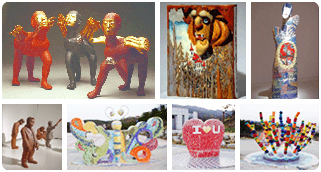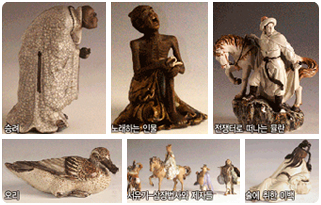서브메뉴
본문내용
[September 1 ~ October 30, 2003, Icheon World Ceramic Center]
The final selections for prize winners were made by examination of actual works that had passed the preliminary screening conducted in two categories : Ceramics for Use and Ceramics as Expression.
A total of 215 pieces from among 2,454 entries (139 from Ceramics as Expression and 76 from Ceramics for Use) from all over the world passed the preliminary screening, which was done by examining slides. ‘Alfred Summer’ by Sun Koo Yuh won the Grand Prize.


- ‘Now & Now’ presented a wide range of ceramic artworks by artists from seventeen countries including Korea, Asian countries, the US, and European countries to show the essence of the most modern and global ceramic artworks today.
Four commissioners – Kwon Sun-Hyung (Korea), Anton Reijnders (the Netherlands), Ito Ikutaro (Japan), and Metthew Kangas (US) – selected 50 artists most active in expressing the ideas and aesthetics of contemporary ceramics, and who represent each continent. Works presented at ‘Now & Now’ showed new attempts and the potential of contemporary ceramics, and drew the attention of the audience.
An extraordinary collection of masterpieces from the Joseon Dynasty (1392-1920) including two pieces designated as national treasures and five pieces designated as treasures was presented at this exhibition, allowing the viewers to glimpse into the evolution of ceramics during the Joseon period.
A total of 180 pieces including pure white porcelain, blue-and-white porcelain pieces including a jar with a dragon design used at the royal court, porcelain with underglaze iron-brown painted designs, porcelain with underglaze copper-red painted designs, and stationeries were featured. The‘Ceramics in Everyday Living’ section vividly showed how ceramics were used in everyday life during the Joseon period.

[Yeoju World Ceramic Livingware Gallery]
Unlike existing exhibitions which display artworks in a showcase or a stand, ceramic artworks or ceramic products are placed in actual living spaces where they serve as interior decoration. By showing how to produce space with ceramics created with clay, water, and fire, and how widely ceramics can be used in actual living spaces, this exhibition suggested a nature-friendly and yet functional lifestyle suited to the 21st century.
A total of 68 works by 20 ceramic artists were showcased, divided into seven sections : Living room + Resting area; Bedroom + Bathroom; Kitchen + Dining room; Lobby + Resting area; Office + Conference room; Private study and Bar; and Garden.Visitors to ‘Ceramic House’ could rediscover the beauty and functionality of ceramics in everyday living.


- [Yeoju World Ceramic Livingware Gallery]
This special exhibition was arranged to look into the ceramic art world of Pablo Picasso (1881-1973), a master of contemporary art, in commemoration of the 30th anniversary of his death. Viewing the diverse ceramic works Picasso produced over twenty years from the 1940s to 1960s, the audience was attracted by the free-spirited expression of art and totally different aspect of Picasso as a ceramic artist.
To commemorate the 50th anniversary of cultural exchange between Korea and Spain and to celebrate the ‘Year of Spanish Culture in Korea 2003’ designated in commemoration of 30th anniversary of the establishment of the Spanish Embassy in Korea,‘Exhibition in Exhibition’ featuring works by Joan Miro (1893~1983), another master of Spain, was held so that the audience could compare Miro’s works with ceramic works by Picasso.
Masterpieces by the world’s top ten chinaware brands, which are trendsetters on the global market, were assembled together to introduce global trends in ceramic livingware to Korea.
The exhibition highlights the particular characteristics and trends of ceramics produced by each company and by their country of origin, through which viewers could see the future of utilitarian ceramic designs.
Participating companies : Augarten (Austria), Arabia (Finland), Herend (Hungary), Meissen (Germany), Richard Ginori (Italy), Rosenthal (Germany), Royal Copenhagen (Denmark), Sevres (France), Villeroy & Boch (Germany), Wedgewood (UK)

This special exhibition showcased the tradition and modernity of Korean ceramics and aesthetic characteristics of Korean ceramics in a refined setting.
Unique works from buncheong in diverse shapes with freely expressed designs to refined white porcelain vessels with simple beauty, traditional tea bowls and tea utensils, and to large-scale onggi sculptures based on traditional onggi by 22 artists with creative minds who interpreted traditional buncheong, white porcelain, and onggi to suit to modernity were presented.
The display technique that highlighted the natural beauty of Korea using plants from nature and other natural elements was of particular interest to the audience.


- ‘Toya Land II,’ presented outdoor of Icheon World Ceramic Center, showed a new world of ceramic sculpture with yet another charm that set it apart from in door exhibitions.
Visitors could enjoy artworks while resting in a natural environment. This exhibition provided an opportunity to highlight the harmony between ceramics and nature, as well as the potential of ceramics as environmental art and ceramic sculpture as public art.
In particular, it served as a forum where new aesthetic values of ceramic art to be created by being in harmony with nature were discovered.

- [Gwangju Joseon Royal Kiln Museum]
Guangdong Province inherited a distinctive ceramic tradition called Shiwan Ceramics.
Shiwan Ceramics is famous for its multifarious techniques, realistic expression, and colorful painting. It is especially famous for ceramic figurines.
This exhibition featuring ceramic
figurines from Guangdong Provincial Museum was arranged as a means of cultural exchange between Gyeonggi-do Province and Guangdong Province.
For the first time in Korea, 78 ceramic figurines in the collection of Guangdong Provincial Museum were presented. The figurines fully showed the realistism of depiction unique to China and exquisite expression, and they drew the interest of the audience.
[Icheon World Ceramic Center]
Eighty works representing each period from the 12th to 20th centuries, which were selected from the collection of the National Ceramics Museum in Barcelona, Spain were exhibited. This was the first exhibition to introduce the history of Spanish ceramics, the center of ceramics in modern Europe, to Korea.
This was in commemoration of ‘the Year of Spain 2003.’ It served an opportunity for the Koreans to learn about the history of European ceramics and its aesthetic characteristics and ceramic culture of Spain.














 Gyeonggi Ceramics Biennale
Gyeonggi Ceramics Biennale

































